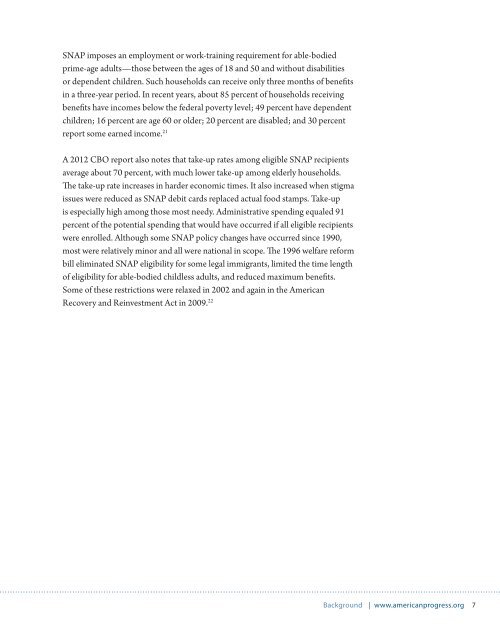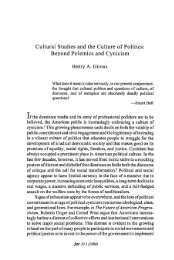effects-of-minimum-wages-on-snap
effects-of-minimum-wages-on-snap
effects-of-minimum-wages-on-snap
You also want an ePaper? Increase the reach of your titles
YUMPU automatically turns print PDFs into web optimized ePapers that Google loves.
SNAP imposes an employment or work-training requirement for able-bodied<br />
prime-age adults—those between the ages <str<strong>on</strong>g>of</str<strong>on</strong>g> 18 and 50 and without disabilities<br />
or dependent children. Such households can receive <strong>on</strong>ly three m<strong>on</strong>ths <str<strong>on</strong>g>of</str<strong>on</strong>g> benefits<br />
in a three-year period. In recent years, about 85 percent <str<strong>on</strong>g>of</str<strong>on</strong>g> households receiving<br />
benefits have incomes below the federal poverty level; 49 percent have dependent<br />
children; 16 percent are age 60 or older; 20 percent are disabled; and 30 percent<br />
report some earned income. 21<br />
A 2012 CBO report also notes that take-up rates am<strong>on</strong>g eligible SNAP recipients<br />
average about 70 percent, with much lower take-up am<strong>on</strong>g elderly households.<br />
The take-up rate increases in harder ec<strong>on</strong>omic times. It also increased when stigma<br />
issues were reduced as SNAP debit cards replaced actual food stamps. Take-up<br />
is especially high am<strong>on</strong>g those most needy. Administrative spending equaled 91<br />
percent <str<strong>on</strong>g>of</str<strong>on</strong>g> the potential spending that would have occurred if all eligible recipients<br />
were enrolled. Although some SNAP policy changes have occurred since 1990,<br />
most were relatively minor and all were nati<strong>on</strong>al in scope. The 1996 welfare reform<br />
bill eliminated SNAP eligibility for some legal immigrants, limited the time length<br />
<str<strong>on</strong>g>of</str<strong>on</strong>g> eligibility for able-bodied childless adults, and reduced maximum benefits.<br />
Some <str<strong>on</strong>g>of</str<strong>on</strong>g> these restricti<strong>on</strong>s were relaxed in 2002 and again in the American<br />
Recovery and Reinvestment Act in 2009. 22<br />
Background | www.americanprogress.org 7




